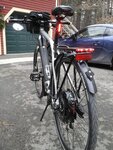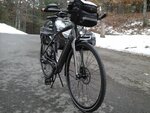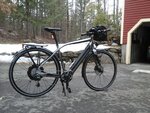Douglas Ruby
Well-Known Member
- Region
- USA
- City
- Groton
Today I picked up the Specialized fender and rack kit for my 2016 base Turbo and installed it. Installation was pretty straightforward but with a few issues.
1. The screws and washers included did not quite match what was called for in the installation instructions.
2. The rear fender was prewired down to the bottom bracket. You have to pull the seat post and unplug the seat light. Then you pull the rear light wire down through the seat tube (from the open access plate under the bottom bracket).
3. The problem is that the wire from the battery and from the seat light each have 1 male and 1 female spade connectors. The wire from the rack light has 2 male connectors. I ended up soldering one side and plugging in the other side.
4. There appears to be some kind of electronics in the rack reflector that drives the rack light. When you turn the battery off, it takes a while (minutes) for the tail light in the rack to bleed down. I disconnected the wires and took the battery out of the bike and the light kept going!
5. I still am augmenting the taillight with a flashing light on the seat post.
I will put pictures up when I get a chance.
Doug
1. The screws and washers included did not quite match what was called for in the installation instructions.
2. The rear fender was prewired down to the bottom bracket. You have to pull the seat post and unplug the seat light. Then you pull the rear light wire down through the seat tube (from the open access plate under the bottom bracket).
3. The problem is that the wire from the battery and from the seat light each have 1 male and 1 female spade connectors. The wire from the rack light has 2 male connectors. I ended up soldering one side and plugging in the other side.
4. There appears to be some kind of electronics in the rack reflector that drives the rack light. When you turn the battery off, it takes a while (minutes) for the tail light in the rack to bleed down. I disconnected the wires and took the battery out of the bike and the light kept going!
5. I still am augmenting the taillight with a flashing light on the seat post.
I will put pictures up when I get a chance.
Doug


